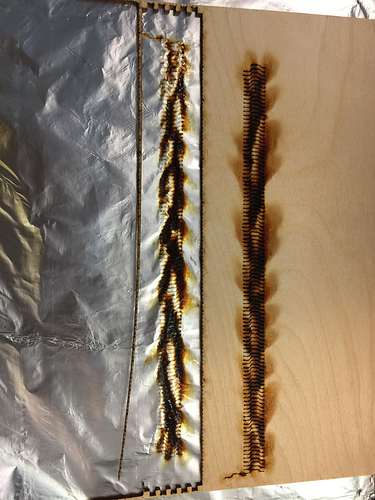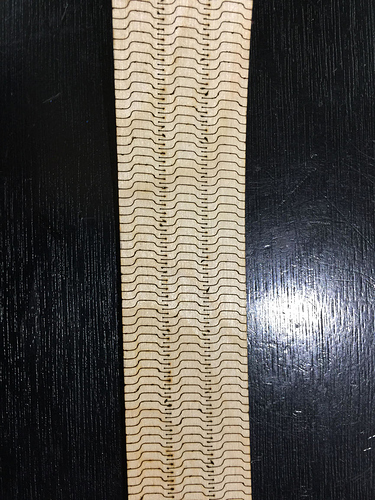Nope.
I use one of those thin plastic cutting sheets that replaced cutting boards. Works great.
I didn’t know how much I’d use mine, but felt a little “flush” towards the end of last year, and upgraded. I don’t use the passthru much - actually, I’ve never even removed the guard off the back , but I have the front (I leave it off) because not only can I use the slot to put larger pieces in, but it also allows a quick adjustment of material as a cut is running, for whatever reason. No, I’m not looking thru the slot - I use a scrap or one of my many rulers to slide in and nudge it if needed.
Hold on… I hear the laser police at the door… brb…
Step away from the laser and come out with your remaining hand where we can see it!
Might be worth checking what those sheets are made of, if you mean your laying you work on top before you cut ?
John 
I need it to cover my remaining eye…
No. I use the sheet to slide in over the piece as I remove it to prevent the one way rubber door from preventing me from sliding the materials the “wrong way”.
Ah, I seem to have got it upside down ! No change there, then.
John 
I must have done it wrong in my experiment. 
I flipped the wood to show the effect. Of course, this was a living hinge, so lots of cuts and I could test with lower power, but I used the settings that usually are just enough for this project.
That’s flashback all right. No real surprise. You could mask the back and/or play with the power levels. I find that when I do stuff that contains a lot of short vectors the head doesn’t always have time to get up to the rated speed and so power levels that are right for bigger jobs end up being too much.
(A really super-brilliant motion planner for the GF could figure out speed-control issues and modify the path so that there were run-up segments with the laser off, and then just turn on when it hit the right place. Sure it could.)
Ouch. Yeah, I’ve never done it with nearly that much laser punching through.
I usually mask. The aluminum foil was just a test. The foil seems to have amplified the flashback issues. It might be interesting to test if I can use lower than typical power and the foil would encourage it to finish the cut. Not sure that it would work that way.
Here is what the exact same design, settings and material look like when simply masked. I think that the settings are fine.
Was the foil shiny side up or dull side? (Not sure it would matter to the GF’s wavelength.)
dull. Was that a bad decision? Maybe @geek2nurse can share which side she puts up to catch itty bitty bits.
I only did it the once, but I swear I remember it working just fine!
My guess would be I put it shiny side up, simply because it wouldn’t have occurred to me not to, because to me, that’ the “right” side.
Although among the alien mind control factions, the issue of whether tinfoil hats should have the shiny side in or out is a hotbed of contention.
Do aliens use lasers for mind control? Maybe we could leverage some of that knowledge here…
Oh no. THAT’s why my tin foil hat hasn’t worked?
I have a few ideas:
- Dull side scatters laser and causes wider marking.
- Reduced power is possible because energy is not lost to crumb tray.
There’s a part of me that says that scattered laser doesn’t make sense because I would think that it would lose it’s energy.
I would love to figure this out though, because I would like to avoid small pieces going into the crumb tray for things such as living hinges. It’s a pain to have to remove the tray.
Could be! Or you might have a pinhole somewhere. There’s also a school of thought that an additional layer of Velostat is necessary. (I learn interesting things in my line of work!)
As for YOUR particular application – it dawns on me that my material would also have been masked on the backside, since so far I’ve mostly only used ![]() stuff, and that may have played a role in reducing flashback for me. I’ve been racking my brain trying to remember when I did it, and I think it must have been for cutting out small inlay pieces for earrings. The pattern density would have been much lower than yours, so that probably factored in, too.
stuff, and that may have played a role in reducing flashback for me. I’ve been racking my brain trying to remember when I did it, and I think it must have been for cutting out small inlay pieces for earrings. The pattern density would have been much lower than yours, so that probably factored in, too.
Duh!
If the reason we can’t do much with metal and a CO2 laser is because the metal dissipates heat too quickly, then to me that means metal should absorb the energy and dissipate it reducing flashback. Clearly that is not the case. Perhaps a sacrificial layer of wood?
I have experienced flashback with the crumb tray and material that has the backside masked. The masking absorbs some of the energy, but if enough is reflected back the material underneath can be damaged.
Is this flashback or the thin air gap between the foil and the wood allowing soot to collect and smoke/residue to stay close to the piece?
It actually may be this…

